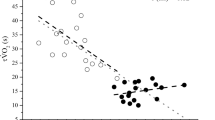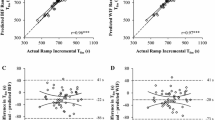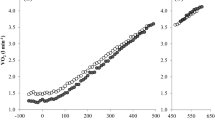Abstract
An incremental ramp exercise is a protocol that is frequently used in the domain of exercise testing to get an insight into the exercise tolerance of both healthy active populations (including athletes) and patients, due to the specific characteristics of the protocol. The continuous and linear increase in work rate is not only less strenuous for populations with a very low exercise capacity but it requires the aerobic metabolism to adapt to the continuously changing conditions. Therefore, this protocol can provide important information on the adaptive capacity of individuals to exercise in non-steady-state conditions. The ramp exercise has also been used in the past two decades to get an insight into the underlying mechanisms of the oxygen uptake (\(\dot V\)O2) response (and kinetics) to exercise. Against the expectations, it has been shown that the parameters that quantify the \(\dot V\)O2 response to ramp exercise do not completely correspond to those obtained from constant work-rate transitions and incremental step exercise. For that reason, it could be concluded that the \(\dot V\)O2 response is specific to ramp exercise, and thus is determined by other mechanisms than those which determine other protocols. Although the \(\dot V\)O2 response to ramp exercise has a high level of reproducibility and a uniform pattern can be observed, especially for the \(\dot V\)O2 response below the gas exchange threshold (GET) [above the GET, the \(\dot V\)O2 response is less clear, some prudence is necessary when interpreting potential differences in the \(\dot V\)O2 response between populations. Several methodological issues (e.g. baseline work rate, ramp slope) exert an important impact on the \(\dot V\)O2 response to ramp exercise. The main purpose of this review is to provide an overview of the methodological and physiological factors that have an impact on the \(\dot V\)O2 response to ramp exercise. It is of importance that exercise physiologists take these factors into consideration, not only prior to the conductance of the ramp exercise in a variety of subjects, but also when interpreting the obtained results.







Similar content being viewed by others
References
Krogh A, Lindhard J. The regulation of respiration and circulation during the initial stages of muscular work. J Physiol (London) 1913; 47: 112–36
Henry FM. Aerobic oxygen consumption and alactic debt in muscular work. J Appl Physiol 1951; 3: 427–38
Linnarsson D. Dynamics of pulmonary gas exchange and heart rate changes at start and end of exercise. Acta Physiol Scand Suppl 1974; 415: 1–68
Whipp BJ, Ward SA, Lamarra N, et al. Parameters of ventilatory and gas exchange dynamics during exercise. J Appl Physiol 1982; 52: 1506–13
Whipp BJ, Wasserman K. Oxygen uptake kinetics for various intensities of constant-load work. J Appl Physiol 1972; 33: 351–6
Buchfuhrer MJ, Hansen JE, Robinson TE, et al. Optimizing the exercise protocol for cardiopulmonary assessment. J Appl Physiol 1983; 55: 1558–64
Boone J, Koppo K, Bouckaert J. The \(\dot V\)O2 response to submaximal ramp cycle exercise: influence of ramp slope and training status. Respir Physiol Neurobiol 2008; 161: 291–7
Jones AM, Campbell IT, Pringle JS. Influence of muscle fibre type and pedal rate on the \(\dot V\)O2 -work rate slope during ramp exercise. Eur J Appl Physiol 2004; 91: 238–45
Whipp BJ, Davis JA, Torres F, et al. A test to determine parameters of aerobic function during exercise. J Appl Physiol 1981; 50: 217–21
Stegemann J. Beitrag zum dynamik der atmungs-regelung bei leichter muskelarbeit. Z Biol 1958; 110: 449–56
Whipp BJ, Mahler M. Dynamics of gas exchange during exercise. In: West JB, editor. Pulmonary gas exchange. Vol. II. New York: Academic Press, 1980: 33–96
Wigertz O. Dynamics of ventilation and heart rate in response to sinusoidal work in man. J Appl Physiol 1970; 29: 208–18
Barstow TJ, Molé PA. Linear and nonlinear characteristics of oxygen uptake kinetics during heavy exercise. J Appl Physiol 1991; 71: 2099–106
Trappe S, Harber M, Creer A, et al. Single muscle fibre adaptations with marathon training. J Appl Physiol 2006; 101:721–7
Davis JA, Whipp BJ, Lamarra N, et al. Effect of ramp slope on determination of aerobic parameters from the ramp exercise test. Med Sci Sports Exerc 1982; 14: 339–43
Swanson GD, Hughson RL. On the modelling and interpretation of oxygen uptake kinetics from ramp work rate tests. J Appl Physiol 1988; 65: 2453–8
Markovitz GH, Sayre JW, Storer TW, et al. On the issues of confidence in determining the time constant for oxygen uptake kinetics. Brit J Sports Med 2003; 38: 553–60
Meyer K, Schwaibold M, Hajric R, et al. Delayed \(\dot V\)O2 kinetics during ramp exercise: a criterion for cardiopulmonary exercise capacity in chronic heart failure. Med Sci Sports Exerc 1998; 30: 643–8
Beaver WL, Wasserman K, Whipp BJ. A new method for detecting anaerobic threshold by gas exchange. J Appl Physiol 1986; 60: 2020–7
Coyle EF, Sidossis LS, Horowitz JF, et al. Cycling efficiency is related to the percentage of type I muscle fibres. Med Sci Sports Exerc 1992; 24: 782–8
Gaesser GA, Brooks GA. Muscular efficiency during steady state exercise: effects of speed and work rate. J Appl Physiol 1975; 38: 1132–9
Wasserman K, Hansen JE, Sue D, et al. editors. Principles of exercise testing and interpretation. 4th ed. Philadelphia (PA): Lippincot Williams and Wilkins, 2005: 11–53
Hansen JE, Casaburi R, Cooper DM, et al. Oxygen uptake as related to work rate increment during cycle ergometer exercise. Eur J Appl Physiol 1988; 57: 140–5
Zoladz JA, Rademaker AC, Sargeant AJ. Non-linear relationship between O2 uptake and power output at high intensities of exercise in humans. J Physiol 1995; 488: 211–7
Barstow TJ, Jones AM, Nguyen PH, et al. Influence of muscle fibre type and fitness on the oxygen uptake/power output slope during incremental exercise in humans. Exp Physiol 2000; 85: 109–16
Scheuermann BW, McConnell JHT, Barstow TJ. EMG and oxygen uptake responses during slow and fast ramp exercise in humans. Exp Physiol 2002; 87: 91–100
Lucia A, Rivero JP, Serrano AL, et al. Determinants of \(\dot V\)O2 kinetics at high power outputs during a ramp exercise protocol. Med Sci Sports Exerc 2002; 34: 326–31
Pedersen PK, Sörensen JB, Jensen K, et al. Muscle fibre type distribution and nonlinear \(\dot V\)O2/power output relationship in cycling. Med Sci Sports Exerc 2002; 34: 655–61
Zoladz JA, Duda K, Majerczak J. Oxygen uptake does not increase linearly at high power outputs during incremental exercise test in humans. Eur J Appl Occup Physiol 1998; 77: 445–51
Bickham DC, Gibbons C, Le Rossignol PF. \(\dot V\)O2 is attenuated above the lactate threshold in endurance-trained runners. Med Sci Sports Exerc 2004; 36: 297–301
Lucia A, Hoyos J, Santalla A, et al. Kinetics of \(\dot V\)O2 in professional cyclists. Med Sci Sports Exerc 2002; 34: 320–5
Zoladz JA, Korzeniewski B. Physiological background of the change point in \(\dot V\)O2 and the slow component of oxygen uptake kinetics. J Physiol Pharmacol 2001; 52: 167–84
Poole DC, Schaffartzik W, Knight DR, et al. Contribution of exercising legs to the slow component of oxygen uptake kinetics in humans. J Appl Physiol 1991; 71: 1245–53
Gollnick PD, Piehl K, Saltin B. Selective glycogen depletion pattern in human muscle fibres after exercise of varying intensity and at varying pedalling rates. J Physiol (London) 1974; 241: 45–57
Cannon DT, White AC, Andriano MF, et al. Skeletal muscle fatigue precedes the slow component of oxygen uptake kinetics during exercise in humans. J Physiol 2011; 589: 727–39
Zoladz JA, Gladden BL, Hogan MC, et al. Progressive recruitment of muscle fibers is not necessary for the slow component of \(\dot V\)O2 kinetics. J Appl Physiol 2008; 105: 575–80
Gore CJ, Clark RJ, Shipp NJ, et al. CPX/D underestimates \(\dot V\)O2 in athletes compared with an automated Douglas bag system. Med Sci Sports Exerc 2003; 35: 1341–7
Day JR, Rossiter HB, Coats EM, et al. The maximally attainable \(\dot V\)O2 during exercise in humans: the peak vs. maximum issue. J Appl Physiol 2003; 95: 1901–7
Data on file, Boone J, 2007
Hughson RL, Inman MD. Oxygen uptake kinetics from ramp work tests: variability of single test values. J Appl Physiol 1986; 61: 373–6
Data on file, Boone J, 2006
Hintzy-Cloutier H, Zameziati K, Belli A. Influence of the base-line determination on work efficiency during sub-maximal cycling. J Sports Med Phys Fitness 2003; 43: 51–6
Kautz SA, Neptune RR. Biomechanical determinants of pedalling energetics: internal and external work are not independent. Exerc Sport Sci Rev 2002; 30: 159–65
Neptune RR, Kautz SA. Muscle activation and deactivation dynamics: the governing properties in fast cyclical human movement performance. Exerc Sports Sci Rev 2001; 29:76–81
Hansen EA, Andersen JL, Nielsen JS. Muscle fibre type, efficiency and mechanical optima affect freely chosen pedal rate during cycling. Acta Physiol Scand 2002; 176: 185–94
Takaishi T, Ono T, Yasuda Y. Relationship between muscle fatigue and oxygen uptake during cycle ergometer exercise with different ramp slope increments. Eur J Appl Physiol 1992; 65: 335–9
Beelen A, Sargeant AJ. Effect of prior exercise at different pedalling frequencies on maximal power in humans. Eur J Appl Physiol 1993; 66: 102–7
Sargeant AJ. Human power output and muscle fatigue. Int J Sports Med 1994; 15: 116–21
Zoladz JA, Duda K, Majerczak J. \(\dot V\)O2/power output relationship and the slow component of oxygen uptake kinetics during cycling at different pedaling rates: relationship to venous lactate accumulation and blood acid-base balance. Physiol Res 1998; 47: 427–38
Fukuba Y, Hayashi N, Koga S, et al. \(\dot V\)O2 kinetics in heavy exercise is not altered by prior exercise with a different muscle group. J Appl Physiol 2002; 92: 2467–76
Jones AM, Koppo K, Burnley M. Effect of prior exercise on metabolic and gas exchange responses to exercise. Sports Med 2003; 33: 949–71
Jones AM, Carter H. Oxygen uptake-work rate relationship during two consecutive ramp exercise tests. Int J Sports Med 2004; 25: 415–20
Boone J, Bouckaert J, Barstow TJ, et al. Influence of priming high intensity exercise on the deoxy[hb+Mb] response to ramp exercise. Eur J Appl Physiol 2012; 112: 1143–52
Marles A, Mucci P, Legrand R, et al. Effect of prior exercise on the \(\dot V\)O2/work rate relationship during incremental exercise and constant work rate exercise. Int J Sports Med 2006; 27: 345–50
Crow MT, Kushmerick MJ. Chemical energetics of slow-and fast-twitch muscles of the mouse. J Gen Physiol 1982; 79: 147–66
Kushmerick MJ, Meyer RA, Brown RT. Regulation of oxygen uptake consumption in fast- and slow-twitch muscle. Am J Physiol 1992; 236: C598–606
Willis WT, Jackman MR. Mitochondrial function during heavy exercise. Med Sci Sports Exerc 1994; 26: 1347–54
Vollestad NK, Blom PCS. Effect of varying exercise intensity on glycogen depletion in human muscle fibres. Acta Physiol Scand 1985; 125: 395–405
Barstow TJ, Jones AM, Nguyen PH, et al. Influence of muscle fibre type and pedal frequency on oxygen uptake kinetics of heavy exercise. J Appl Physiol 1996; 81: 1642–50
Mogensen M, Bagger M, Pedersen PK, et al. Cycling efficiency in humans is related to low UCP3 content and to type I fibres but not to mitochondrial efficiency. J Physiol 2006; 571: 669–81
Medbø JI. Type I and type II fibres work with the same mechanical efficiency during bicycling. In: Maréchal G, Carraro U (eds). Muscle and mobility. Vol. 2. Hampshire: Intercept Ltd, 1990: 303–8
Costill DL, Fink WJ, Pollock ML. Muscle fibre composition and enzyme activities of elite distance runners. Med Sci Sports Exerc 1976; 8: 96–100
Casaburi R, Storer TW, Ben-Dov I, et al. Effect of endurance training on possible determinants of \(\dot V\)O2 during heavy exercise. J Appl Physiol 1987; 62: 199–207
Hagberg JM, Hickson RC, Ehsani AA, et al. Faster adjustment to and recovery from submaximal exercise in the trained state. J Appl Physiol 1980; 48: 218–24
Koppo K, Bouckaert J, Jones AM. Effects of training status and exercise intensity on phase II \(\dot V\)O2 kinetics. Med Sci Sports Exerc 2004; 36: 225–32
Boone J, Koppo K, Barstow TJ, et al. Aerobic fitness, muscle efficiency and motor unit recruitment during ramp exercise. Med Sci Sports Exerc 2010; 42: 402–8
Mallory LA, Scheuermann BW, Hoelting BD, et al. Influence of peak \(\dot V\)O2 and muscle fibre type on the efficiency of moderate exercise. Med Sci Sports Exerc 2002; 34: 1279–87
Neder JA, Nery LE, Peres C, et al. Reference values for dynamic responses to incremental cycle ergometry in males and females aged 20 to 80. Am J Respir Crit Care Med 2001; 164: 1481–6
Kilding AE, Jones AM. \(\dot V\)O2 ‘overshoot’ during moderate-intensity exercise in endurance-trained athletes: The influence of exercise modality. Respir Physiol Neurobiol 2008; 160: 139–46
Koppo K, Whipp BJ, Jones AM, et al. Overshoot in \(\dot V\)O2 following the onset of moderate-intensity cycle exercise in trained cyclists. Eur J Appl Physiol 2004; 93: 366–73
Barclay CJ. Mechanical efficiency and fatigue of fast and slow muscles of the mouse. J Physiol 1996; 497: 781–94
Prieur F, Benoit H, Busso J, et al. Effect of endurance training on the \(\dot V\)O2 -work rate relationship in normoxia and hypoxia. Med Sci Sports Exerc 2005; 37: 664–9
Gross MA, Breil FA, Lehamn AD, et al. Seasonal variation of \(\dot V\)O2 max and the \(\dot V\)O2 -work rate relationship in elite alpine skiers. Med Sci Sports Exerc 2009; 41: 2084–9
Gimenes AC, Neder JA, Dal Corso S, et al. Relationship between work rate and oxygen uptake in mitochondrial myopathy during ramp-incremental exercise. Braz J Med Biol Res 2011; 44: 354–60
Itoh H. Oxygen uptake: work rate relationship in patients with heart disease. Med Sci Sports Exerc 1992; 37: 374–80
Jones S, Elliot PM, Sharma S, et al. Cardiopulmonary responses to exercise in patients with hypertrophic cardiomyopathy. Heart 1998; 80: 60–7
Toyofuku M, Takaki H, Sugimachi M, et al. Reduced oxygen uptake increase to work rate increment (Δ \(\dot V\)O2/DW) is predictable by \(\dot V\)O2 response to constant work rate exercise in patients with chronic heart failure. Eur J Appl Physiol 2003; 90: 76–82
Balady GJ, Arena R, Sietsema K. Clinician’s guide to cardiopulmonary exercise testing in adults: a scientific statement from the American Heart Association. Circulation 2010; 122: 191–225
Lewis MI, Belman MJ, Monn SA, et al. The relationship between oxygen consumption and work rate in patients with airflow obstruction. Chest 1994; 106: 366–72
Acknowledgements
No funding was received for the preparation of this review. The authors have no conflicts of interest to declare that are directly relevant to the content of this review. The authors would like to thank Jacques Bouckaert and Wim Derave for their insightful comments and remarks and their contribution to the paper.
Author information
Authors and Affiliations
Corresponding author
Rights and permissions
About this article
Cite this article
Boone, J., Bourgois, J. The Oxygen Uptake Response to Incremental Ramp Exercise. Sports Med 42, 511–526 (2012). https://doi.org/10.2165/11599690-000000000-00000
Published:
Issue Date:
DOI: https://doi.org/10.2165/11599690-000000000-00000




